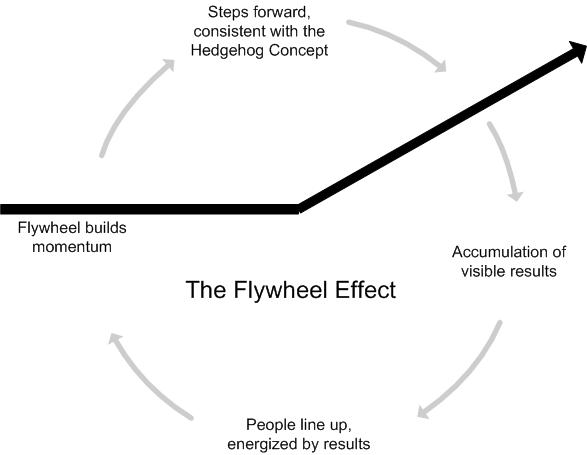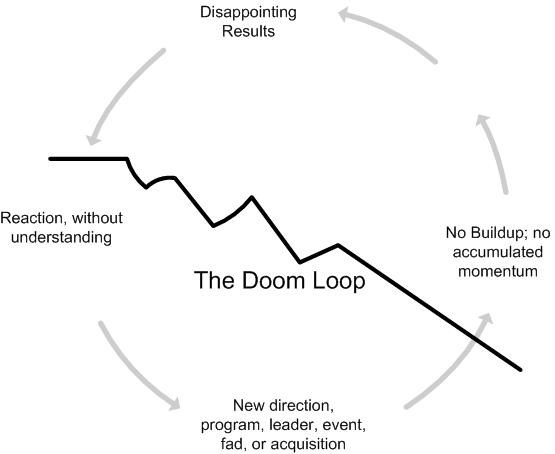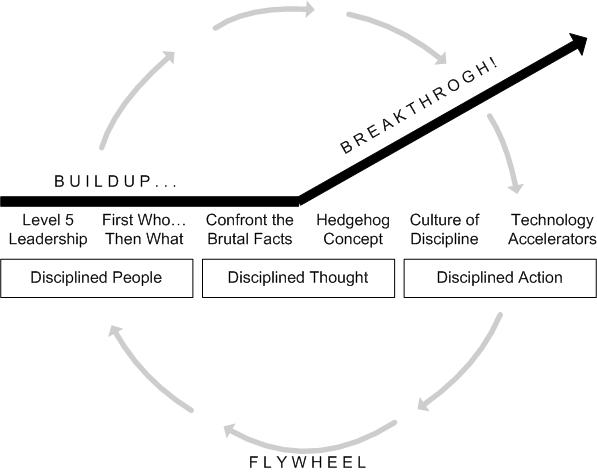
p. 3: Can a good company become a great company and, if so, how? Or is the disease of “just being good” incurable?
p. 11: The good-to-great companies did not focus principally on what to do to become great; they focused equally on what not to do and what to stop doing.
Technology and technology-driven change has virtually nothing to do with igniting a transformation from good to great. Technology can accelerate a transformation, but technology cannot cause a transformation.
p.13: “People are your most important asset” turns out to be wrong. People are not your most important asset. The right people are.
Chapter 2: Level 5 Leadership
p. 20:
- Level 1: Highly capable individuals.
Makes productive contributions through talent, knowledge, skill, and good work habits. - Level 2: Contributing Team Members.
Contributes individual capabilities to the achievement of group objectives and works effectively with others in a group setting. - Level 3: Competent Manager.
Organizes people and resources toward the effective and efficient pursuit of
pre-determined objectives. - Level 4: Effective Leader.
Catalyzes commitment to and vigorous pursuit of clear and compelling vision,
stimulating higher performance standards. - Level 5: Executive.
Builds enduring greatness through a paradoxical blend of personal humility
and professional will.
p. 20, 21: Unwavering resolve . . . to do what must be done.
He could not stand mediocrity in any form and was utterly intolerant of anyone
who would accept the idea that good is good enough.
Chapter 3: First Who … Then What
p.41: The executives who ignited the transformations from good to great did not first figure out where to drive the bus and then get people to take it there. No, they first got the right people on the bus (and the wrong people off the bus) and then figured out where to drive it. They said, in essence, “Look, I don’t really know where we should take this bus. But I know this much: If we get the right people on the bus, the right people in the right seats, and the wrong people off the bus, then we’ll figure out how to take it someplace great.”
p.42: Three simple truths:
- If you begin with “who” rather than “what,” you can more easily adapt to a changing world.
- If you have the right people on the bus, the question of how to motivate and manage people largely goes away.
- If you have the wrong people, it doesn’t matter whether you discover the right direction; you stillwont have a great company.Great vision without great people is irrelevant.
p.50: It’s not how you compensate your executives, it’s which executives you have to compensate in the first place. … The right people will do the right things and deliver the best results they’re capable of, regardless of the incentive system.
p.53: Rigorous, not ruthless. … “The only way to deliver to the people who are achieving is to not burden them with the people who are not achieving.”
To let people languish in uncertainty for months or years, stealing precious time in their lives that they could use to move on to something else, when in the end they aren’t going to make it anyway — that would be ruthless. To deal with it right up front and let people get on with their lives — that is rigorous.
How to be Rigorous
p.54: Practical Discipline #1: When in doubt, don’t hire — keep looking.
Packard’s Law: No company can grow revenues consistently faster than its ability to get enough of the right people to implement that growth and still become a great company. If your growth rate in revenues consistently outpaces your
growth rate in people, you simply will not — indeed cannon — build a great company.
p.55: Practical discipline #2: When you know you need to make a people change, act.
The moment you feel the need to tightly manage someone, you’ve made a hiring mistake. The best people don’t need to be managed. Guided, taught, led — yes. But not tightly managed.
Waiting too long before acting is equally unfair to the people who need to get off the bus. For every minute you allow a person to continue holding a seat when you know that person will not make it in the end, you’re stealing a portion of his life, time that he could spend finding a better place where he could flourish. Indeed, if we’re honest with ourselves, the reason we wait too long often has less to do with concern for that person and more to do with our own convenience.
p.57: “Instead of firing honest and able people who are not performing well, it is important to try to move them once or even two or three times to other positions where they might blossom.” — Alan Wurtzel, Circuit City
p.58: Practical discipline #3: Put your best people on your biggest opportunities, not your biggest problems.
p.63: Good-to-great management teams consist of people who debate vigorously in search of the best answers, yet who unify behind decisions, regardless of parochial interests.
Chapter 4: Confront the Brutal Facts (Yet Never Lose Faith)
p.72: “When you turn over rocks and look at all the squiggly things underneath, you can either put the rock down, or you can say, ‘My job is to turn over rocks and look at the squiggly things,’ even if what you see can scare the hell out of you.” — Fred Purdue, Pitney Bowes
The moment a leader allows himself to become the primary realty people worry about, rather than reality being the primary reality, you have a recipe for mediocrity, or worse. This is one of the key reasons why less charismatic leaders often produce better long-term results than their more charismatic counterparts.
p.74: The real question then becomes: How do you manage in such a way as to not de-motivate people? And one of the single most de-motivating actions you can take is to hold out false hopes, soon to be swept away by events.
p. 74-79: Leading in a climate where truth is heard:
- Lead with questions, not answers.
- Engage in dialogue and debate, not coercion
- Conduct autopsies, without blame
- Build “red flag” mechanisms.Indeed, we found no evidence that the good-to-great companies had more or better information than the comparison companies. None. Both sets of companies had virtually identical access to good information.
The key, then, lies not in better information, but in turning information into information that cannot be ignored.
p.86: The Stockdale Paradox:
- Retain faith that you will prevail in the end, regardless of the difficulties, and at the same time,
- Confront the most brutal facts of your current reality, whatever they might be
Chapter 5: The Hedgehog Concept (Simplicity within the Three Circles)
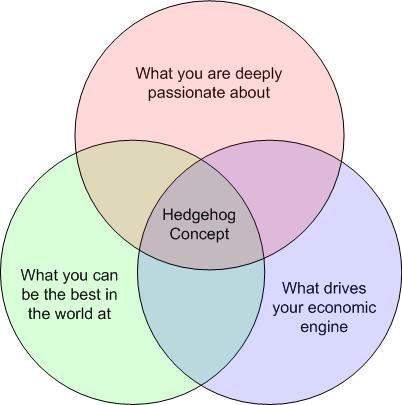
p.91: The essence of profound insight is simplicity. Hedgehogs see what is essential, and ignore the rest.
p. 95-96:
What you can be the best in the world at (and equally important, what you cannot be the best in the world at). This discerning standard goes far beyond the core competence. Just because you possess a core competency doesn’t mean you can be the best in the world at it. Conversely, what you can be the best at might not even be something in which you are currently engaged.
What drives your economic engine. All the good-to-great companies attained piercing insight into how to most effectively generate sustained and robust cash flow and profitability. In particular, they discovered the single denominator — profit per X — that had the greatest impact on their economics. (It would be cash flow per x in the social
sector).
What you are deeply passionate about. The good-to-great companies focused on those activities that ignited their passion. The idea here is not to stimulate passion but to discover what makes you passionate.
p.98: A Hedgehog Concept is not a goal to be the best, a strategy to be the best, an intention to be the best, a plan to be the best. It is an understanding of what you can be the best at. The distinction is absolutely crucial.
p.100: Many people have been pulled or have fallen into careers where they can never attain complete mastery and fulfillment. Suffering from the curse of competence but lacking a clear Hedgehog Concept, they rarely become
great at what they do.
p. 108: If you successfully apply these ideas, but then stop doing them, you will slide backward, from great to good, or worse. The only ay to remain great is to keep applying the fundamental principles that made you great.
P. 109: You can’t manufacture passion or “motivate” people to feel passionate. You can only discover what ignites your passion and the passion of those around you.
p. 115: Characteristics of a Council for arriving at the Hedgehog Concept (see the text)
Chapter 6: A Culture of Discipline
p.121: Most companies build their bureaucratic rules to manage the small percentage of wrong people on the bus, which in turn drives away the right people on the bus, which then increased the percentage of wrong people on the bus, which increases the need for more bureaucracy to compensate for the incompetence and lack of discipline, which then further drives the right people away, and so forth.
p.136: It takes discipline to say “No, thank you” to big opportunities. The fact that something is a “once-in-a-lifetime opportunity” is irrelevant if it doesn’t fit within the three circles.
p. 140: In a good-to-great transformation, budgeting is a discipline to decide which arenas should be fully funded and which should not be funded at all. In other words, the budget process is not about figuring out how much each activity gets, but about determining which activates best support the Hedgehog Concept and should be fully strengthened and which should be eliminated entirely.
p.142: Bureaucratic cultures arise to compensate for incompetence and lack of discipline, which arise from having the wrong people on the bus in the first place. If you get the right people on the bus, and the wrong people off, you don’t need stultifying bureaucracy.
Do not confuse a culture of discipline with a tyrant who disciplines — they are very different concepts, one highly functional, the other highly dysfunctional. Savior CEOs who personally discipline through sheer force of personality usually fail to produce sustained results.
“Stop doing” lists are more important than “to do ” lists.
Chapter 7: Technology Accelerators
p.152: When used right, technology becomes an accelerator of momentum, not a creator of it. The good-to-great companies never began their transitions with pioneering technology, for the simple reason that you cannot make good use of technology until you know which technologies are relevant. And which are those? those – and only those — that link directly to the three intersecting circles of the Hedgehog Concept.
p.153: Does technology fit directly with your Hedgehog Concept? If yes, then you need to become a pioneer in the application of that technology. If no, then ask, do you need this technology at all? If yes, then all you need is parity. (You don’t necessarily need the world’s most advanced phone system to be a great company.) If no, then the technology is irrelevant, and you can ignore it.
Technology alone cannot create sustained great results.
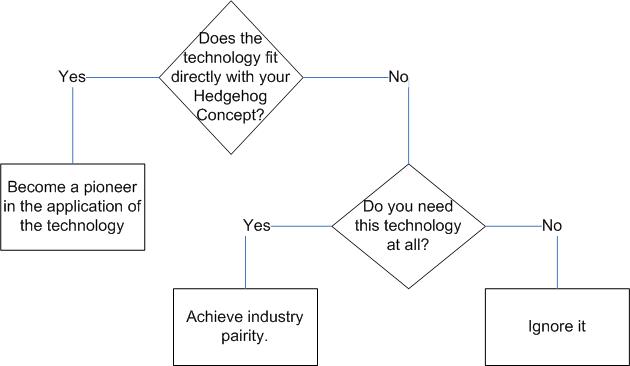
p.160: Those who turn good into great are motivated by a deep creative urge and an inner compulsion for sheer unadulterated excellence for its own sake. Those who build and perpetuate mediocrity, in contrast, are motivated more by the fear of being left behind.
Chapter 8: The Flywheel And The Doom Loop
p.168:We’ve allowed the way transitions look from the outside to drive our perception of what
they must feel like to those going through them on the inside. From the outside, they look like dramatic, almost revolutionary breakthroughs. But from the inside, they feel completely different, more like an organic development process.
